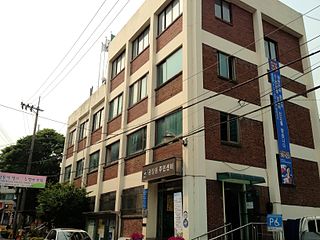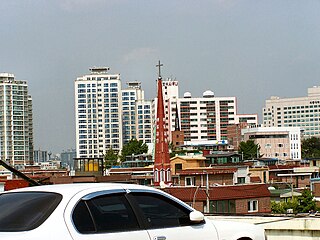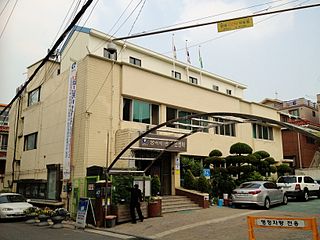Related Research Articles

Seongdong District (Seongdong-gu) is one of the 25 gu which make up the city of Seoul, South Korea. It is situated on the north bank of the Han River. It is divided into 20 dong (neighbourhoods).

Gwangjin District is one of the 25 districts of Seoul, South Korea. It is located on the north bank of the Han River on the eastern end of Seoul. The district was split from the neighboring Seongdong District in 1995.

Ttukseom Park Station is a rapid transit station on Seoul Subway Line 7. It is located in Noyu-dong in the Gwangjin-gu administrative district of Seoul. It is the only station in South Korea to be located on the underside of a bridge, beneath Cheongdam Bridge. The station also runs underneath a highway with two exits being south of the highway and two north. The south exits serve Ttukseom Park, while the north exits serve Noyu-dong which is administered by and consists of Jayang 3-dong and Jayang 4-dong which contain some residential towers with small shops and other mixed commercial and residential areas. The station is serviced by a single bus route which is located at exit 4. Before Line 7 opened the station was known as Jayang Station (자양역).

Ilmin Museum of Art is a private art museum of South Korea, located on Sejongno street in Jongno-gu, a central district of Seoul, known for exhibiting mainly Korean art. The museum was established and run by the Ilmin Cultural Foundation (Korean: 일민문화재단), a non-profit organization founded in 1994 in memory of Kim Sang-man, former president of Dong-A Ilbo, one of the major newspaper companies of South Korea. Kim devoted his entire life to developing Korean journalism and promoting Korean culture. The museum is named after his pen name, "Ilmin".

Jamsil-dong is a neighbourhood, dong, of Songpa-gu, Seoul, South Korea. Its name is derived from silkworm breeding during the Joseon dynasty. Jamsil translates to a room or place for sericulture. The state encouraged people to raise silkworms, so founded Dongjamsil in the east vicinity of Seoul.

Cheongpa-dong is a dong, neighbourhood of Yongsan-gu in Seoul, South Korea.

Bogwang-dong is a dong (neighbourhood) of Yongsan-gu in Seoul, South Korea.

Gwangjang-dong is a dong, neighbourhood of Gwangjin-gu in Seoul, South Korea.

Gunja-dong is a dong, neighbourhood of Gwangjin-gu in Seoul, South Korea. It is a transportation hub located on the southern side of Cheonho-daero, to the left of Jungnangcheon.

Hwayang-dong is a dong located in west Gwangjin-gu in Seoul, South Korea. It was incorporated into Gwangjin-gu on 13 August 1949. It is a mixed residential and small business area. Mojin-dong is also administered by Hwayang-dong and contains Konkuk University.

Junggok-dong is a dong, neighbourhood of Gwangjin-gu in Seoul, South Korea.
Neung-dong is a dong, neighbourhood of Gwangjin-gu in Seoul, South Korea.
Noyu-dong is a dong, neighbourhood of Gwangjin-gu in Seoul, South Korea. It is a legal dong administered under its two administrative dong, Jayang 3-dong and Jayang 4-dong.
Mojin-dong is a dong, neighbourhood of Gwangjin-gu in Seoul, South Korea.
Doryeom-dong is a dong, neighbourhood of Jongno-gu in Seoul, South Korea. It is a legal dong administered under its administrative dong, Sajik-dong. The name is originated from a governmental office named Doryeomseo in the region during the early period of Joseon dynasty.
Pyeong-dong is a dong, neighbourhood of Jongno-gu in Seoul, South Korea. It is a legal dong administered under its administrative dong, Gyonam-dong.

Majang-dong is a dong, or neighbourhood of Seongdong-gu in Seoul, South Korea.
Hongje-dong is a dong, neighbourhood of Seodaemun-gu in Seoul, South Korea.
Bongwon-dong is a legal dong, neighbourhood of the Seodaemun-gu district in Seoul, South Korea and is governed by its administrative dong, Sinchon-dong's office. Bongwon-dong has the Bongwon-Temple(Bongwonsa) built by Great master Doseon (827–898) in 889, 3rd year of Jinseong Queen, the 51st of Shilla Dynasty. Bongwon-Temple gives opportunities for visitors to experience "Seoul Lotus Festival" and "Yeongsamjae ritual" annually.
Cheongjin-dong is a dong, neighbourhood of Jongno-gu in Seoul, South Korea. It is a legal dong administered under its administrative dong, Jongno.
References
- 1 2 "자양동 (Jayang-dong 紫陽洞)" (in Korean). Doosan Encyclopedia. Retrieved 2008-04-22.[ permanent dead link ]
- ↑ "The origin of Jayang-dong" (in Korean). Gwangjin-gu official site. Archived from the original on June 16, 2021. Retrieved 2008-04-22.
- "Chronicle of Beopjeong-dong and Haengjeong-dong" (in Korean). Guro-gu Official website. Archived from the original on 2014-10-06. Retrieved 2008-04-22.